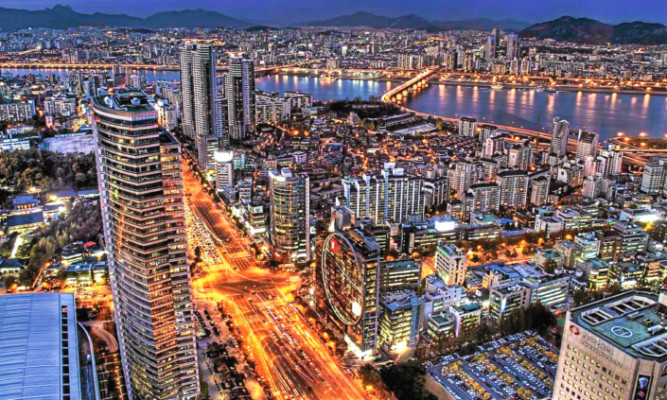
If you’re looking for a fresh take on an Asian adventure, then it’s time to jump on the Seoul train and head for the streamlined sensation that is South Korea’s capital.
Flying into the modern Incheon International Airport, the views wow as the breathtaking green of rugged island landscapes pepper the turquoise blue sea, all leading to the industrial outskirts and high-rise central hub of Seoul.
It’s home to roughly a quarter of the country’s ever-growing 50 million population, making it one of Asia’s most populated cities and Korea’s economic powerhouse.
And in the country that brought Samsung electronics to the world, Seoul is the 21st Century Korea’s capital of cool.
Hip cafes and restaurants line its clean streets, while slick city skyscrapers silhouette each sunset.
However, the city still offers a respectful bow to its proud history, with its 200-year-old entry gates two exquisite examples of how Seoul maintains its intoxicating traditional taste.
Five ancient Royal palaces dating back to the 1300s continue to impress.
Gyeongbokgung, Seoul’s oldest, stands guard in front of the snow-capped peaks of Mount Bugaksan. Entry is free and its grounds house both Korea’s Folk Museum and National Palace.
Travelling within Seoul is a breeze, with ultra-modern, fast, clean and efficient subways.
Signposts are rare, so your best bet if you want to stay over-ground is a taxi swathes of which seem to outnumber potential clients.
Peel off from most streets and you’ll find a goldmine of flavour and culture.
The Myeong-Dong market has hundreds of stalls every night, selling everything from skewer-fried octopus to chocolate hand-spun in more than 120,000 strings of caramel.
However, if it’s a true flavour of Korea that you seek, then in stark contrast to Thailand, Vietnam or Japan shying away from Seoul’s effervescent street food scene will greatly reward your palette.
In line with most Asian meals, chilli, garlic, soy sauce and sesame lie at the heart of Korean cuisine.
Yet, through the pickling of side dishes a traditional Korean food craft known as Kimchi the country has found its own foodie niche.
Almost every vegetable can be fermented in this historic way and is best devoured over the ever-sociable method of table barbecuing (bulgogi).
Cooking over an open flame is the way to eat and share meals, with prime cuts of meat buried in Kimchi, garlic and tangy sauce, folded in an aromatic leaf, eaten whole, and washed down with soju whisky’s Asian pen-pal. Your taste buds will do cartwheels!
Indulge in the treat that’s taking Seoul’s nightlife by storm a crunchy pile of fried chicken, washed down with locally brewed beer.
To sleep it all off, check in to the spell-binding five-star Grand Hyatt Hotel. The lobby offers the best view over the city’s south side. Its rooms, with ceiling-high windows, ensure you never miss out. Although the Thursday night barbecue doesn’t come cheap, after one plateful you’ll be willing to pay double.
Kia and Hyundai dominate the roads here. Snake out of the city and Korea’s modern highways will thrill you behind the wheel. Both brands are globally renowned for their dedication to innovation. A drive in either and you’ll know why Koreans worship them.
North Korea remains a no-go and is still one of the world’s greatest enigmas.
However, head an hour out of Seoul and take in the de-militarised zone between the North and South.
Its exhibits lay bare the horror of the great Korean wars and the viewing dock’s binoculars allow you to peer in on the state’s ‘propaganda villages’ stage props which try to portray comfortable living.
Turn back around, though, and you experience the real thing: South Korea – a beautiful, culturally rich wonderland where old meets new, new meets newer, and where you should try everything… even octopus on a skewer!
Direct flights from London Heathrow to Incheon International Airport, Seoul, take around 11 hours and are available from Korean Air: koreanair.com. Economy flights from £722. The Grand Hyatt Hotel in Seoul has rooms starting at £115: seoul.grand.hyatt.com.

Enjoy the convenience of having The Sunday Post delivered as a digital ePaper straight to your smartphone, tablet or computer.
Subscribe for only £5.49 a month and enjoy all the benefits of the printed paper as a digital replica.
Subscribe